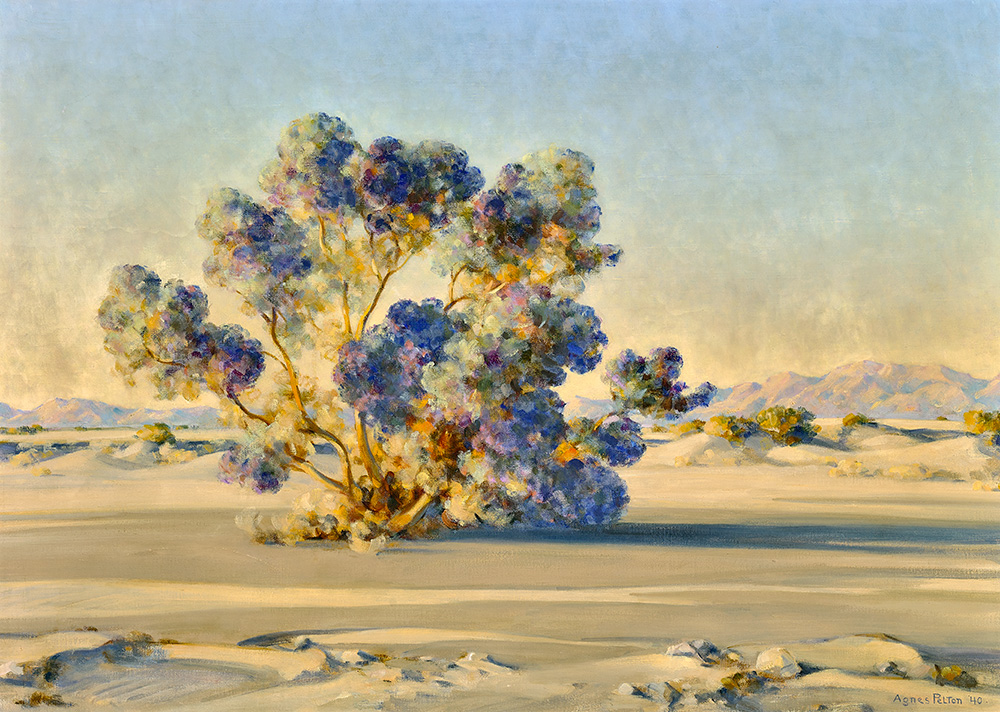Gardena High's Art Collection On View
 |
| Agnes Pelton, Desert Royalty, 1941. Gardena High School collection |
These days it's a big ask to hire an art teacher for a public school. Yet there was a time when a working-class high school could build its own collection of museum-quality contemporary art. From 1919 to 1956, students of Gardena High School paid studio visits and bought paintings to display in their school auditorium. The project received regional and national attention and caused at least one other school (Mira Costa High, Manhattan Beach) to emulate it. A selection of the Gardena collection has just gone on view at the Palos Verde Art Center as "Gifted: Collecting the Art of California at Gardena High School, 1919–1956."
 |
| Franz A. Bischoff, A Cool Fog Drifting, 1924 |
 |
| Emil Kosa, Jr., Every Cloud Has Its Silver Lining, about 1943 |
 |
| Gardena High School, 1936 photo. Collection of Simon K. Chiu |
The collection was the idea of Gardena High principal John H. Whitley. The school was neither wealthy nor large. Gardena, midway between LAX and Compton, was then a farm town with a population of about 3000. Its high school football team was called the Berry Pickers. About a third of the class was Japanese-American. The art-collecting program survived the Great Depression, World War II, and having a third the class (and their parents) sent to detention camps.
The paintings acquired were mostly soothing plein air landscapes and later, American Scene works. The artists worked in L.A. or Pasadena. Many had national reputations at the time, and some are frequently shown in So. Cal. museums: William Wendt, Edgar Payne, Franz Bischoff, Maynard Dixon, and others. The students' most prescient buy may have been an Agnes Pelton. It's not one of the cosmic abstractions she's known for but rather one of the desert landscapes she turned out simultaneously to make a living.
 |
| Jessie Arms Botke, Cranes Under a Giant Fern, about 1943. |
There's a fully characteristic painting by Art Deco/Japonisme-inflected nature painter Jessie Arms Botke, another woman artist whose reputation has been revived lately. I suspect the Gardena students bought more contemporary women artists than museums of the time did.
Not just the students but the local community helped with fundraising drives. Some of the artists gave the students price breaks, and as the program became better known, artists donated works as well.
 |
| Christian von Schneidau, Clown Says Grace, about 1951 |
The Gardena students bought a few clunkers too. There's a thrift-shop-esque Clown Says Grace and a portrait of Ludwig van Beethoven himself, though not from life (c. 1905). It's said that the Beethoven was a favorite with the student body.
 |
| Carlo Wostry, Beethoven, about 1906 |
The last few paintings acquired, in the mid 1950s, had nods to surrealism. Then Gardena High moved to a new campus, and the new principal apparently had no interest in continuing the tradition. The paintings went into a vault lacking climate control and were largely forgotten until recent conservation, a 2019 book, and an ongoing museum tour.
The author of the catalog, Susan Anderson, reports that the collection once contained a number of untraced pieces, including works on paper and a few abstractions. A group of Japanese-American students are said to to have secured donations of modernist pieces from Japanese-American artists, but these remain missing.
"Gifted: Collecting the Art of California at Gardena High School" runs at the Palos Verde Art Center through Nov. 12, 2022.
 |
| Robert Watson, Remains, 1954 |
Comments
In the huge expanse of time and space, technical skill seems more common than artistic/creative skill is. In another instance, the style or technique of, say, Pre-Raphealites has always bothered me. But in the past, at least either the factor of technique or artistry could be measured.
Nowadays, both skills - increasingly affected by politics too (less so, provincialism) - are coming down to a case of: "Altogether in the eye of the beholder."